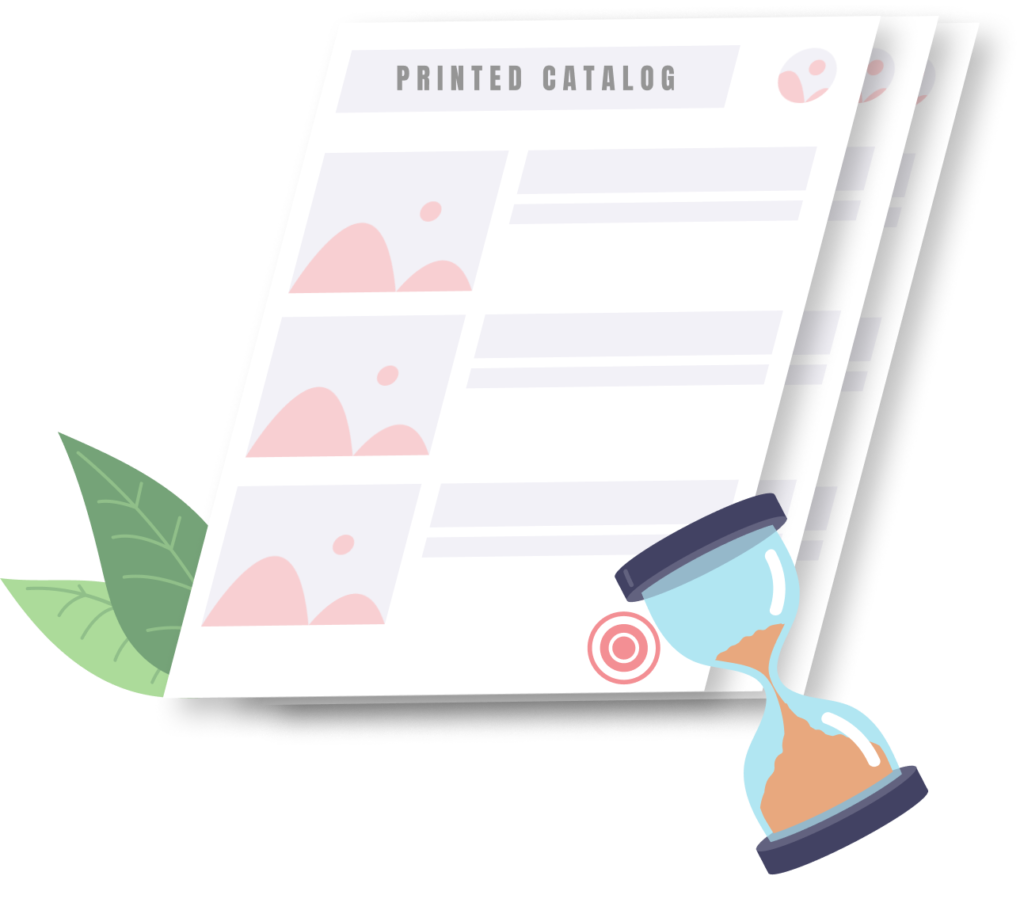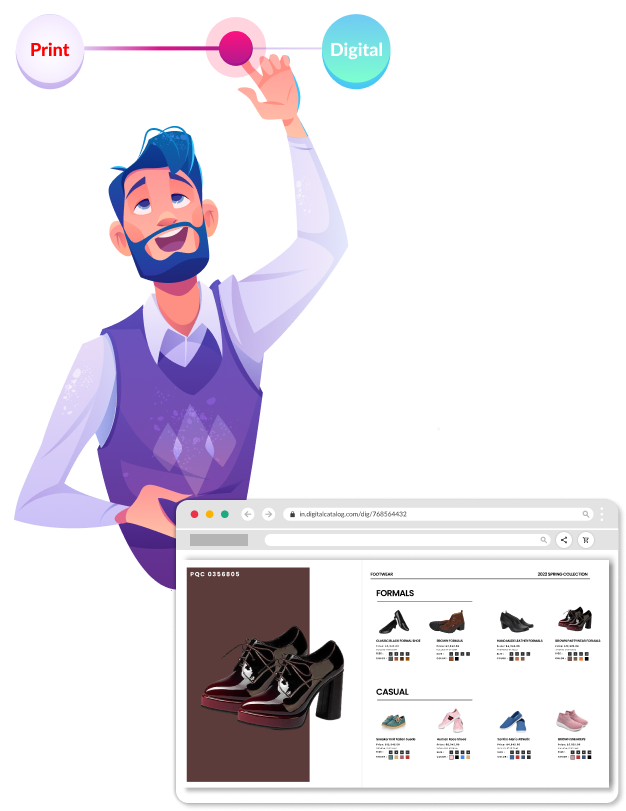Catalogs have always been a key marketing tool for both B2B & B2C companies. It allows businesses to showcase their product line to potential consumers in the form of a comprehensive document containing all the essential information that will aid consumers in making an informed buying decision.
For years, sales reps have been using printed catalogs to sell to customers and build product awareness. They were used widely in brick-and-mortar retail stores as the single most important source of product information for incoming customers.
However, with the rise of eCommerce, physical catalogs are facing steep competition from digital catalogs that are easier to maintain, are cost-effective, and provide a much better user experience.
As a result, companies are now resorting to digital catalogs to meet consumer expectations and create a more flexible sales ecosystem that puts buyer convenience at the heart of things.
In this blog, we will be finding answers to the following:
- Why print catalogs might be a thing of the past?
- Why digital catalogs are a better option than printed catalogs in eCommerce
- How digital catalogs improve the sales experience for buyers?
- How digital catalogs pave the way for efficient product information management?
Why print catalogs might be a thing of the past?

There’s no denying the tactile experience that print catalogs offer. Given the increasingly saturated and noisy digital space where the large number of brands are continuously vying for the attention of the same captive audience through a barrage of digital ads, emails, push notifications, and tailor-made offers, print catalogs surely offer consumers the clarity and space to think through their buying decisions without getting distracted.
But from an operational standpoint, maintaining print catalogs proves to be an expensive affair. With every new batch of products introduced, discontinued SKUs, revised pricing, or latest offers launched, suppliers are required to create a fresh set of catalogs for their sales reps to keep up their marketing activities.
The time required to create a new set of catalogs combined with increasing printing costs are reasons why businesses around the world are now resorting to digital catalogs. Also, with the rise of eCommerce, the role of catalogs has evolved from that of a standard document to gather product information to a critical marketing resource that can be customized to the needs of the buyers.
Users are now seeking features like faceted search and contract pricing in catalogs for a more convenient sales experience. The sheer lack of these flexibilities is why digital catalogs are preferred over print catalogs.
Why digital catalogs are a better option than printed catalogs in B2B eCommerce?

Simply put, digital catalogs are easier to maintain, and sustainably built, and businesses do not have to incur high repeat expenditures on printing to ensure the latest catalogs are reaching the hands of the buyers.
A one-time purchase of a digital catalog-making software can eliminate these challenges by enabling manufacturers to keep churning out up-to-date catalogs that also integrate with eCommerce and ERP systems to give both businesses and buyers a hassle-free sales experience.
These tools come with built-ready design templates and an option to directly upload products and relevant information to create attractive catalogs that can be readily shared with buyers as PDFs to take orders and payments.
The following are some of the more important reasons why digital catalogs are central to B2B eCommerce success:
1. Cross-Platform Compatibility:
Nowadays, buyers are used to searching for products online at their own convenience. Digital catalogs ensure products are easily found and accessible online across all devices and smartphones. As a result, buyers can look up products seamlessly from any device and on any channel at their own convenience without even interacting with a sales rep.
The ability to search and shop on their own is what makes digital catalogs so competitive in the eCommerce landscape.
2. Showcase Products Attractively:
Using digital catalogs, manufacturers can create a visually enriching experience for buyers by showcasing products at their finest using high-definition photos, videos, GIFs and even interactive pop-ups. This will help buyers gain in-depth information about the products and are more likely to go ahead with the purchase.
3. Standardize Product Information:
Being able to standardize high volumes of product data and present it to buyers in a structured manner is the key to increasing customer engagement and sales. Digital catalogs help suppliers do exactly that by organizing product information in a way that buyers can access it in clicks. Tagging and categorizing your digital catalogs correctly is a sure-shot way to make buying more convenient for your customers.
4. Faceted Search:
With digital catalogs, you can offer customers the option to search your website with specific keywords to exactly view what they are looking for. This spares them the hassle of scrolling through your entire website, making shopping enjoyable and at the same time decreasing check-out time.
5. Provide Contract Pricing:
Digital catalogs offer the flexibility of providing contract pricing to select customers as opposed to print catalogs where the same pricing will apply to everyone you share the catalog with. Easily modify product pricing, share with your prospects and win more accounts with a personalized sales approach.
6. Create Custom Catalogs:
Dig into consumer buying data on your eCommerce portal and use that to create custom catalogs for your specific clients. There’s really no point sharing all the products with everyone. Instead, choose products that are frequently ordered by someone and create a catalog for them using SKUs of just those products and share with them. This personalized approach will not only increase customer satisfaction but also boost sales.
How digital catalogs improve sales experience for buyers?

Unlike print catalogs that buyers can access only at retail stores or during in-person interaction with the sales reps, digital catalogs can be accessed anytime, anywhere, on any device.
They are designed to work seamlessly across a wide range of devices and platforms. Customers can browse it on their desktops and then pick it back from the same place on their mobiles and continue to checkout.
In B2B eCommerce, digital catalogs can be used to personalize buying experiences by offering clients specific products at contract pricing without sharing the entire product line with them that is useful exclusively to their business.
How digital catalogs pave the way for efficient product information management?

There are two aspects to digital catalogs – catalog making and catalog management. Digital catalog making is the process of building catalogs, line sheets, and lookbooks on the fly.
This empowers sales reps to operate with more freedom and flexibility as they can curate catalogs and line sheets independently based on the prospects’ needs and share them as PDFs or unique links. The prospects can use them to explore products and place orders directly without visiting the eCommerce portal.
This eliminates internal dependencies and gives sales reps the flexibility to maintain a tight follow-up schedule with leads, cater to their custom requirements easily, and generate more sales.
Whereas, digital catalog management is the process of maintaining up-to-date supplier catalogs on your eCommerce website so your visitors always have access to the latest product information, no matter which device or channel they access from.
Maintaining high-quality and consistent product data with alluring images and videos on your eCommerce store makes your customers trust your brand more, which positively influences their decision to buy from you.
For eCommerce retailers, digital catalog management is a powerful way to increase customer engagement and sales. In many ways, digital catalogs act much like a PIM – a single source of product information and any changes made to the same reflect across all your sales channels.
This prevents duplication errors and automates hundreds of manual data management processes to help save time and effort and let online retailers focus on better things – like selling more and scaling their business.
SellersCommerce’s new catalog management solution exclusively for uniform retailers that enables them to subscribe to catalog updates from 130+ suppliers and receive up-to-date product feeds directly on their eCommerce store. It works by integrating with all major eCommerce platforms like Shopify, Volusion, WooCommerce, BigCommerce, and more to push the latest product updates to the store’s backend. Without this tool, retailers.
Getting started with digital catalogs on your online store.
If you are looking to maximize the performance of your online store by switching to digital catalogs and want to empower your sales team by giving them the freedom to create, edit and share line sheets on the fly to drive more closures – we at SellersCommerce have the right tools for you.
To get started for FREE, visit: www.linesheetspro.com